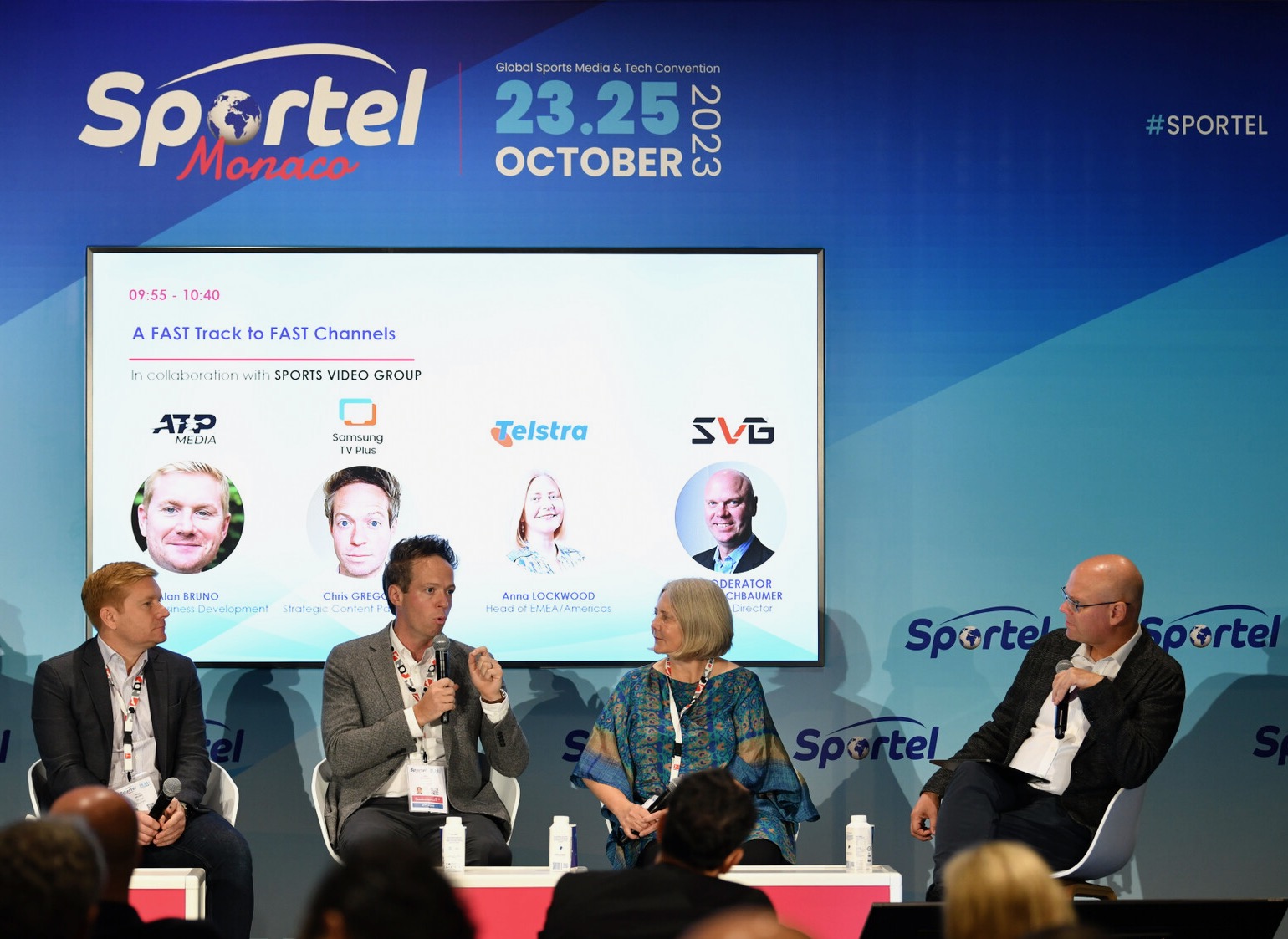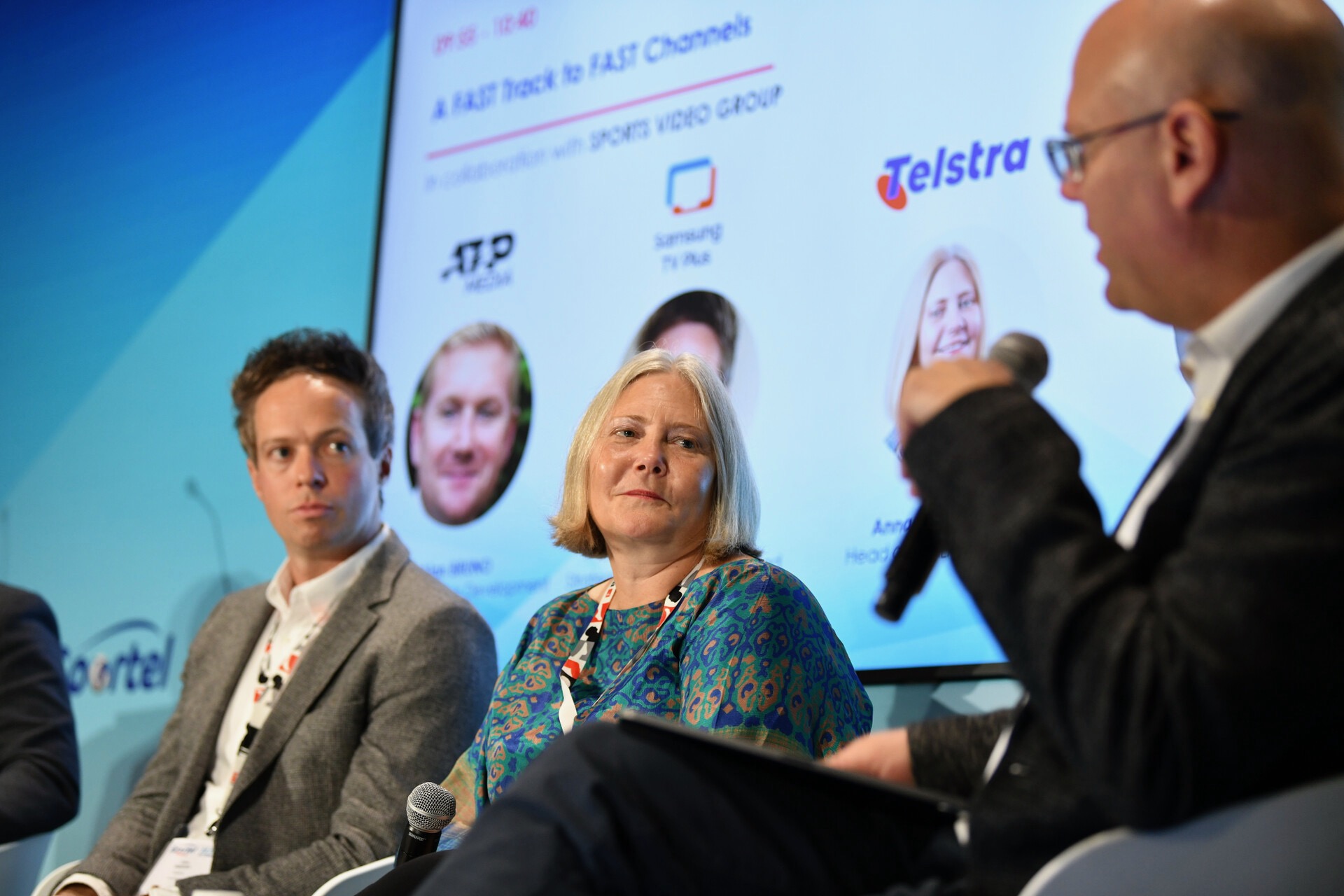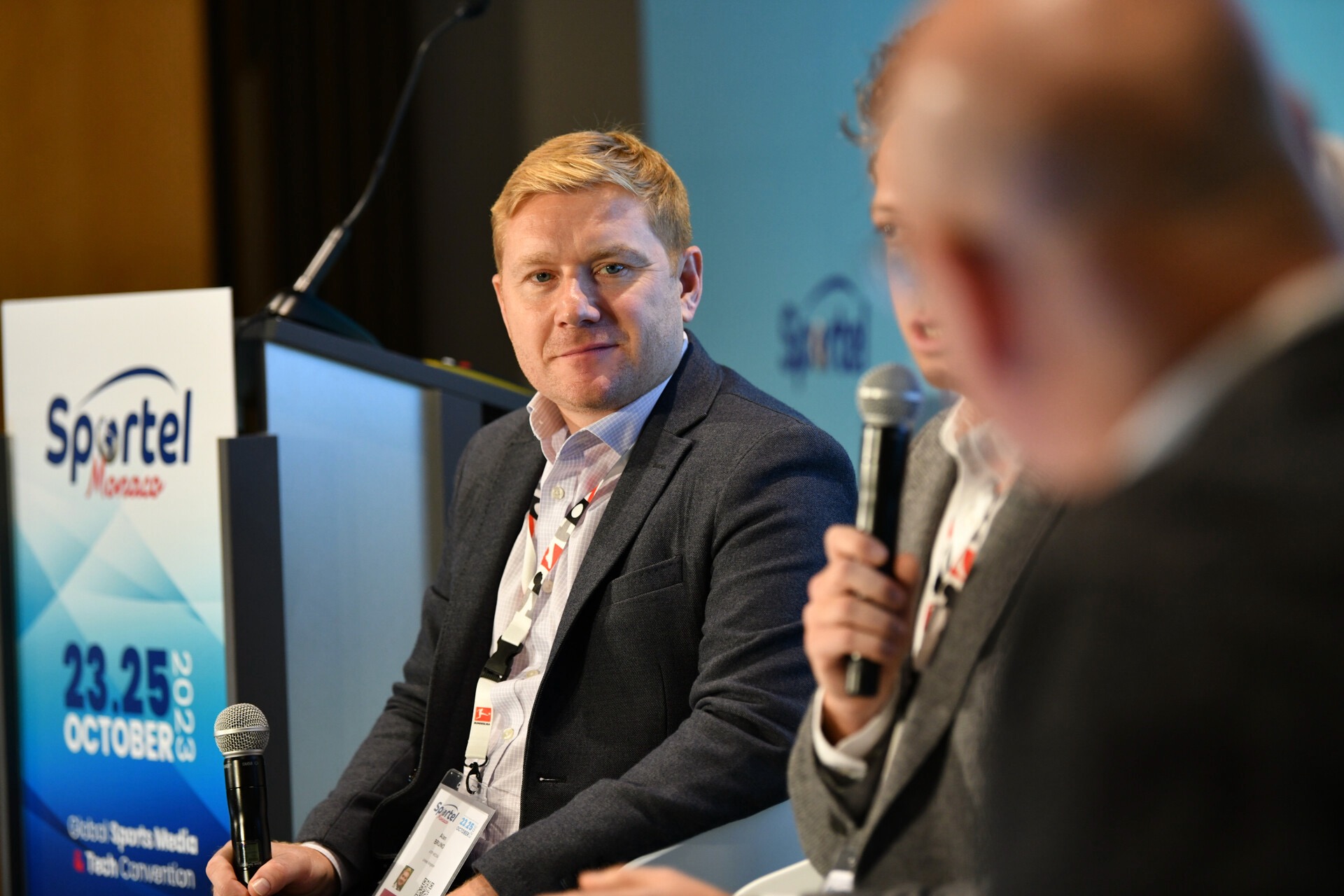FAST Channels Part One: Samsung, ATP Media, Telstra Discuss Ins and Outs of Launching, Managing Free Ad-Supported Streaming
Sportel Monaco session dives deep into the elements of FAST success
Story Highlights
The rise of FAST (free ad-supported streaming) has been undeniable in the past two years, and a recent Sportel Monaco panel, moderated by SVG Co-Executive Director Ken Kerschbaumer, featured three key entities either involved in or seriously investigating a FAST sports service: Samsung (represented by Chris Gregory, strategic content partner, lead, Samsung TV Plus); Telstra Broadcast Services (Anna Lockwood, head of EMEA/Americas, Telstra Broadcast Services); and ATP Media (Alan Bruno, head of broadcast development, ATP Media). Below is Part 1 of a two-part edited transcript from that conversation, which examines what FAST channels are, how to get started, and more.
FAST Channels will also be front and center at SVG’s Digital Engagement Workshop on Dec. 11 as part of the 2023 SVG Summit in New York City (click here to register today!).

FAST panel at Sportel: (from left) ATP Media’s Alan Bruno, Samsung’s Chris Gregory, Telstra Broadcast Services’ Anna Lockwood, and moderator SVG’s Ken Kerschbaumer
Chris, can you walk us through what FAST is from the Samsung-platform perspective?
Gregory: Sure. So, what is FAST? Free ad-supported streaming television. And Samsung, which is the number-one TV manufacturer in the world, was the very first adopter of the FAST platform, launched in the U.S. in 2015. My remit is Europe, [with] 16 countries in the European service and around 1,300 channels across 250 partners. That’s a lot of partners to look after, and they range across all genres.
I think what we’re looking at now is more broadcast-quality partners, moving into that space rather than potentially digital first. Sport is a big driver at a television-sales level as we know from the data that we see whenever there’s a World Cup. Whether that be male or female football or even the recent Rugby World Cup, there are big sales at a device level. We want to flow that down into our own service as well.
Can you explain the user experience if you own a Samsung TV?
Gregory: The service runs on 2016- to 2023-year TV models, and we’re also available on selected Galaxy mobile and tablet devices. We sit prominently on the home screen next to the biggest SVOD and BVOD players as well. We’re taking FAST very seriously. It’s our own service, and whilst there has been huge progress over the last three, four years, there’s still more to come.
Alan, you are with ATP Media, and you are looking at FAST. Please give us a sense of the rights landscape, your current offerings around apps and streaming, and where you see FAST fitting into that equation.
Bruno: We look at FAST as a potential additional vertical of our wider content strategy. We are not a channels business, we’re in broadcast. We monetize 60-plus tournaments across the ATP Tour each year and also operate an SVOD service, Tennis TV. We also have short-form content across social and a publisher network as well. We are looking at FAST as potentially an additional vertical, maybe using some archive content, potentially looking at dark-market solutions for some of our tournaments. We don’t have many dark markets left, but we are looking at that as a potential option.
But we are also looking at it as a way potentially to find a more general audience, a different audience. We’re certainly super-serving the tennis fan. Could we perhaps use this as a way of reaching the wider, more general sports fan or general entertainment fan? We’re looking at it closely and, obviously, speaking to guys like Chris around the distribution solutions. But what we need to make sure is, we are looking at it probably on a market-by-market basis with the broadcast partner in a market or with our SVOD platform in mind.
What are some of the questions that pop up when your internal team discusses FAST?
Bruno: We want to make sure it’s got the right brand identity. We didn’t want to launch just an archive channel. I think, a few years ago, the FAST landscape was very focused on people monetizing their archive, the content that was sitting on the shelf. We want it to form part of our wider content strategy. Yes, it would utilize some of the archive, but we also want it to connect with our other touchpoints with our fans.
Gregory: When it comes to sport, live is a big push, and I think the launch of the DAZN FAST Plus, which happened last December, gave us premium football content that we never thought we were going to get from three of the biggest leagues in the world. We also had an exclusive Champions League highlight show. This is the kind of thing that we speak to partners about. We don’t expect partners just to launch blindly into this space; we’re very hands-on, and we’ll see what’s working, what’s not and advise from there.
Chris, how did the DAZN deal come about?
Gregory: The initial conversation started about two years ago. We’ve got a very strong relationship with DAZN because they’ve got the app business that’s prominent in Germany as well as on our home screen and other markets. They’ve got loads of archive, but, at the same time, because DAZN looked to disrupt the market, they had carved out live rights to add into their FAST channels. It was just making sure that they weren’t necessarily impacting their day-to-day business. And then we worked together on the Champions League show. I don’t think there’s any free-to-air highlights package for the Champions League in Germany and Austria, so it was, “How can we make this channel something special and set the mark in the sector?” And in the sports sector, not just the FAST sector.

From left: Chris Gregory, Anna Lockwood, and Ken Kerschbaumer discussed the need for good technology partners to handle the lift required to launch and manage a FAST channel.
Anna, Telstra Broadcast Services is at the core of getting a lot of content around the globe. Are you hearing your customers discuss FAST channel, and what does that mean to your services and offerings?
Lockwood: As a broadcast-services provider, we are always following our customers and our clients, and I think everyone will agree that sports is underserved in the FAST ecosystem and live sports is absolutely underserved in the FAST ecosystem. As our clients are looking towards live sports specifically, we take a consultative role, but sometimes we also take a technology role. One of the things that people need is content from anywhere in the globe, many different protocols, going into AWS, the S3 bucket and then put into the right format to get to the platform required.
Often with live sports and especially high-value live sports, you’re looking at a one-plus-one: you’re looking at that redundancy that would have a very optimal viewing experience downstream. We work with the tech partners, we work with the platforms, and we work with rightsholders, content owners to make sure that, especially in live sports, you have a really good viewing experience and can get content from anywhere in the world to the usual AWS availability zone.
Gregory: Anna, I’m sure Telstra covers it as well, but, with anything with live rights, we also make sure that DRM and all the protection is there with things like geo-blocking. With our service in 24 countries globally, the last thing that we want is to do a deal in Germany and suddenly the channel pops up and you can watch it in the U.S. All the protection from an IP level is built in, and that’s how we work with our technical partners as well.
Chris, what other sports entities is Samsung involved with, and how do you make them more discoverable?
Gregory: We have the PGA as well as Sport Italia channels in Italy, and we also have a La Liga channel in Spain and a re-broadcast channel of RTVE in Spain, where we’re fortunate enough to have the FIFA Women’s and Men’s World Cup. Viewership is through the roof. When there’s a sporting occasion, we will probably move the channels up into the feature section, so discoverability is easier, and will have promotion, on the platform with marketing banners on the home screen of our TVs. When a channel launches, we don’t want it to just be there stagnant with no one knowing about it. We work with the partners before a launch so they have a set launch date, a set submission date. During that time, we also work on what they can do with their social channels, what they can do on their own platform as well as on ours.

Alan Bruno said ATP Media sees FAST channels as a way to serve dark markets and grow the ATP fan base.
Bruno: We wouldn’t look to just develop a channel with a partner and hand it over to a platform. We would leverage our existing content team that work across content we produce for our broadcast partners that work on short-form or long-form content for our SVOD product. We’d leverage that excellent team, which are already producing that content, and they would be working on the channel scheduling, creating something compelling that the platforms are able to promote, get behind just so we are not producing a channel and leaving it. We want to be close to it even though we probably would need to rely on a third-party tech solution.
Do you think you would need to form a FAST-channel team to manage it?
Bruno: I think we’d probably look at it. We’ve got a fantastic team that’s doing similar stuff in that scheduling space, and we would probably use those guys but also have a good focus on this day-to-day. It depends on the size of the opportunity and where it goes.
Lockwood: The role of digital-media manager or digital-content manager might not be a full-time job, but it’s definitely a key role. Again, as a consumer, if I’m looking at a channel, I’m expecting the icons to be updated, the information to be refreshed. To your discoverability point, it’s not at all a set-and-forget. If you’re attracting sports viewers, I think that that role is absolutely important.
Gregory: That is an absolutely fantastic point. I think, [with] the packaging of the sports channel, you don’t want to see just the logo of ATP; you want to see who’s actually playing. That draws people in because FAST is a sit-back environment: you want to switch your brain off after a busy day or an event where you’re, like, “I just want to disappear within my TV.” Having that graphic where it’s the match or the teams playing the match, the athletes in it draw people in. The engagement is key.
Chris, who are some of the technology partners you work with?
Gregory: The tech-integration partners do a lot of the legwork. For Samsung TV Plus, we work with Wurl, Amagi, and Xumo as our middle team between us getting the content partner and getting it onto the service. They have great teams, and, once the feed is submitted to us a month before launch via one of our tech-integration partners, we’ve got a fully set Q&A team to ensure that all the model TVs are working, there are no blackouts, the ad markers are working, etc. And then our supply-ops team, who run all the ad tags and set those up, get involved. When a channel goes live, we’re not waiting for mistakes to happen. All the ads start running.
Lockwood: One of the great value-adds of the tech providers is that so much of this is automated. The reason why, maybe not for high-value live sports but for a sports channel, you can get up and running, spin up/spin down very quickly, is this background automation. But new things do come up, which can make that a little bit more challenging. If you have a FAST provider who has graphics, then you can add different kinds of advertising. But, if you don’t have a technology provider who has that graphics platform, you have less abilities but at a lower cost. It depends on what your budget is and where you’re trying to go, but there’s background automation from an Amagi, a Frequency, a Wurl that makes it very cost-effective so it can become a freemium service.
Chris, on that note, can you walk us through the revenue models?
Gregory: We’ve got three different models. In revenue share, Samsung Ads sell all of the inventory, and we’ll share a remittance form on a monthly basis with the channel. If a partner comes to us with a sales house, we’ll do an inventory-share deal, where we’ll have a slice of the inventory to sell and likewise the partner. The third is licensing, where we license content or have flat fees and we create an owned-and-operated channel.
Stay tuned for Part 2 later this week as we look at what FAST will mean for smaller organizations, how to create a compelling service, and much more.
